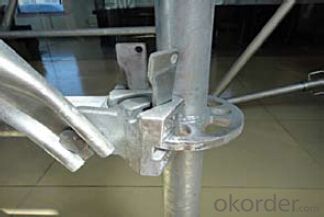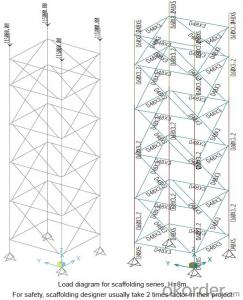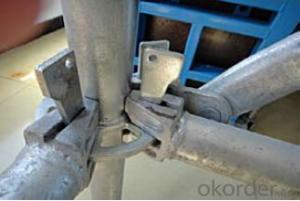Ring-lock scaffolding Accessories for Formwork and Scaffolding System
- Loading Port:
- Tianjin
- Payment Terms:
- TT OR LC
- Min Order Qty:
- 50 m²
- Supply Capability:
- 1000 m²/month
OKorder Service Pledge
Quality Product, Order Online Tracking, Timely Delivery
OKorder Financial Service
Credit Rating, Credit Services, Credit Purchasing
You Might Also Like
Ring-lock Scaffolding
A support system for construction, ownsadvantages of both cup-lock scaffolding andshoring tower.
It is in the development direction of new typescaffolding.
It is widely used in buildings, bridges, tunnels etc..
Characteristics:
◆ Easy to storage and transportation
◆ High degree of standardization
◆ Easy and quick erection
◆ Excellent stability and bearing capacity
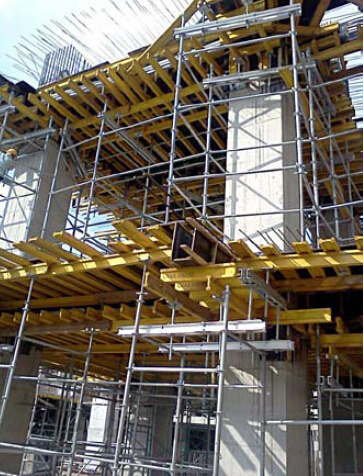
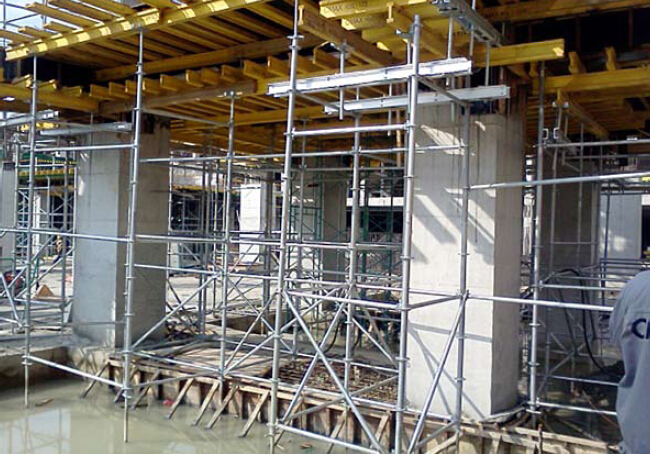
- Q: How does steel formwork accommodate for different concrete curing temperatures?
- Accommodating various concrete curing temperatures is easily achieved with steel formwork, thanks to its versatility and reliability. The standout characteristic of steel formwork is its exceptional thermal conductivity, which effectively dissipates heat from curing concrete. This unique property enables the steel formwork to effectively regulate the concrete's temperature during the curing process. When precise control over the concrete curing temperature is necessary, steel formwork can be equipped with additional features to meet these requirements. For example, insulation materials can be applied to the steel formwork to minimize heat loss or gain, ensuring a consistent and steady curing temperature. This adaptation proves especially beneficial in extreme weather conditions when the ambient temperature can have a significant impact on the curing process. Furthermore, steel formwork can be combined with heating or cooling systems to further regulate the concrete curing temperature. In colder weather conditions, heating elements can be integrated into the steel formwork to maintain an optimal temperature for proper curing. Similarly, in hotter weather conditions, cooling systems can be employed to prevent excessive heat from affecting the curing process. In addition to its temperature control capabilities, steel formwork boasts exceptional strength and durability, making it an ideal choice for accommodating various concrete curing temperatures. The robust nature of steel formwork allows it to withstand the pressure and stresses exerted by the curing concrete, regardless of the temperature. This ensures that the formwork remains intact and stable throughout the curing process, preventing any deformations or failures that could compromise the quality of the concrete structure. Overall, steel formwork offers a comprehensive solution for accommodating different concrete curing temperatures. Its high thermal conductivity, compatibility with insulation materials, and integration with heating or cooling systems make it a versatile option. Additionally, its strength and durability guarantee its ability to withstand the challenges posed by varying curing temperatures, ensuring successful and optimal concrete curing.
- Q: Can steel formwork be used for high-rise buildings?
- Yes, steel formwork can be used for high-rise buildings. Steel formwork offers several advantages such as durability, strength, and flexibility, making it suitable for large and complex structures like high-rise buildings. It can withstand the pressure exerted by concrete, ensuring structural stability during the construction process. Additionally, steel formwork allows for smooth and precise concrete finishing, facilitating the construction of high-quality, aesthetically appealing high-rise buildings.
- Q: How does steel formwork affect the overall construction cost?
- The overall construction cost can be significantly impacted by steel formwork. Although the initial cost of steel formwork may be higher than that of timber or aluminum formwork, it offers various advantages that can lead to cost savings in the long run. To begin with, steel formwork is highly durable and has a longer lifespan when compared to other materials. This implies that it can be used multiple times, reducing the need for new formwork in future projects. Consequently, the cost of purchasing or renting formwork for subsequent projects decreases, resulting in overall cost savings. Furthermore, steel formwork is renowned for its strength and stability. This enables faster construction processes, as it can withstand higher concrete pressures, leading to quicker cycle times. The ability to achieve faster construction speeds can reduce labor costs and shorten the overall construction timeline, resulting in cost savings. Moreover, steel formwork ensures excellent quality and precision in concrete structures. It enables accurate shaping and forming of concrete elements, resulting in better finishes and fewer defects. This can reduce the requirement for additional finishing work, repairs, or rework, leading to cost savings in terms of materials and labor. Additionally, steel formwork enhances safety on construction sites. Its stability and strength enable it to withstand adverse weather conditions and prevent accidents. By ensuring a safe working environment, potential delays and costs associated with accidents or injuries can be minimized. Lastly, steel formwork is known for its versatility and adaptability. It can be easily customized to meet various project requirements, allowing for flexibility in design and construction. This versatility can lead to optimized construction processes and materials, ultimately reducing costs. In conclusion, although the initial cost of steel formwork may be higher, its durability, strength, speed, accuracy, safety, and versatility can result in significant cost savings in terms of reusability, labor, materials, and time. Therefore, steel formwork plays a positive role in the overall construction cost by providing long-term value and efficiency.
- Q: What are the common safety guidelines when working with steel formwork in hazardous areas?
- To ensure the protection of workers and prevent accidents, certain safety guidelines must be adhered to when working with steel formwork in hazardous areas. Here are some commonly recommended safety guidelines: 1. Personal Protective Equipment (PPE): Workers must wear appropriate PPE, such as safety goggles, gloves, steel-toed boots, and hard hats, to safeguard themselves from potential hazards. 2. Training and Education: Adequate training on working with steel formwork and awareness of the specific hazards in the hazardous areas are essential. This includes understanding safe handling practices and emergency procedures. 3. Hazard Identification and Risk Assessment: Thoroughly assess the hazardous areas before starting work to identify potential risks and hazards. This will facilitate the implementation of suitable safety measures and controls. 4. Fall Protection: Proper fall protection measures should be in place when working at heights, including guardrails, safety harnesses, and safety nets. Workers should be trained on the correct use of fall protection equipment and systems. 5. Fire Safety: In hazardous areas, there is an increased risk of fire. Ensure the availability of fire extinguishers, train workers in their use, and have emergency evacuation plans in place. 6. Electrical Safety: Ensure proper grounding of electrical equipment or tools near the steel formwork and regularly inspect them for safety. Workers should exercise caution and avoid contact with live wires. 7. Proper Handling and Storage: Proper handling and storage of steel formwork materials are crucial to prevent injuries. This includes using appropriate lifting equipment, securely fastening the formwork, and storing it in designated areas to avoid tripping hazards. 8. Adequate Ventilation: If working in confined spaces, ensure proper ventilation to prevent the accumulation of toxic gases or fumes. Workers should be trained to recognize signs and symptoms of exposure to hazardous substances. 9. Regular Inspections and Maintenance: Regularly inspect the steel formwork and surrounding areas to identify any potential safety hazards. Promptly carry out any necessary repairs or maintenance. 10. Communication and Emergency Procedures: Establish clear communication between workers, supervisors, and other stakeholders to ensure awareness of potential hazards and emergency procedures. Regular safety meetings and drills can strengthen this communication. By adhering to these common safety guidelines, workers can minimize the risks associated with working with steel formwork in hazardous areas and create a safer working environment.
- Q: Can steel formwork be used for both interior and exterior applications?
- Yes, steel formwork can be used for both interior and exterior applications. Steel formwork is highly durable and can withstand various weather conditions, making it suitable for both indoor and outdoor construction projects. Its versatility and strength make it a preferred choice for many construction applications.
- Q: How does steel formwork affect the overall moisture resistance of the structure?
- Steel formwork does not directly affect the overall moisture resistance of the structure as it is primarily used as a temporary mold for concrete placement. However, if not properly sealed or if there are gaps between the steel formwork and the concrete, it can potentially lead to water infiltration and compromise the moisture resistance of the structure.
- Q: Can steel formwork be used for underwater concrete structures?
- Yes, steel formwork can be used for underwater concrete structures. Steel is a durable and strong material that can withstand the pressure and corrosive effects of water. It provides a reliable support system for pouring and shaping concrete in underwater conditions, ensuring the stability and integrity of the structure.
- Q: How does steel formwork affect the overall seismic performance of a structure?
- There are several ways in which the overall seismic performance of a structure can be significantly affected by steel formwork. To begin with, during the construction process, steel formwork acts as a rigid and robust temporary support system. This ensures that the concrete is aligned and placed correctly, which is vital for the structural integrity of the building. By providing precise formwork, steel helps in creating a well-designed structure that can withstand seismic forces. Furthermore, the strength and stiffness of the concrete structure are enhanced by steel formwork. Steel is renowned for its high tensile strength, enabling it to resist the lateral forces caused by earthquakes. This increased strength and stiffness can help reduce deformation and damage caused by seismic activities. Additionally, steel formwork can prevent crack formation and improve the durability of the structure as a whole. In addition, steel formwork contributes to the ductility of a building. Ductility refers to a structure's ability to undergo significant deformations without sudden failure. Steel formwork allows for the creation of reinforced concrete elements, such as beams and columns, which can absorb and dissipate seismic energy through plastic deformations. This plastic behavior aids in redistributing seismic forces and reducing the structure's overall vulnerability. Moreover, steel formwork facilitates the use of innovative structural systems like steel plate shear walls, moment frames, or braced frames. These systems are designed to enhance seismic resistance by dissipating energy and controlling deformations during earthquakes. Steel formwork enables precise fabrication and installation of these systems, ensuring their effectiveness in improving the structure's seismic performance. In conclusion, steel formwork is crucial in enhancing the overall seismic performance of a structure. It provides temporary support, enhances concrete strength and stiffness, improves ductility, and enables the use of innovative seismic-resistant systems. By incorporating steel formwork in the construction process, engineers can create structures that are better equipped to withstand the destructive forces of earthquakes.
- Q: How does steel formwork affect the overall dimensional stability of a structure?
- Steel formwork can significantly impact the overall dimensional stability of a structure in a positive manner. Due to its inherent strength and rigidity, steel formwork provides excellent support during the construction process, ensuring accurate and precise concrete placement. This results in a structure with improved dimensional stability as the steel formwork helps to maintain the designed shape and dimensions. The use of steel formwork offers several advantages that contribute to the overall dimensional stability. Firstly, steel is known for its high strength-to-weight ratio, which allows for the creation of sturdy and durable formwork systems. This strength translates into better resistance against deformation, preventing any shifts or movements in the formwork during concrete pouring. As a result, the final structure is less likely to experience dimensional changes, ensuring the desired shape and dimensions are maintained. Additionally, steel formwork provides superior dimensional accuracy compared to other formwork materials. Steel plates or panels used in the formwork can be manufactured with high precision, resulting in consistent dimensions and smooth surfaces. This precision eliminates any inconsistencies or irregularities that may arise from using traditional formwork materials like wood or plywood, further enhancing the overall dimensional stability of the structure. Moreover, steel formwork is highly resistant to moisture, humidity, and temperature variations, which can often lead to dimensional changes in other materials. Steel's resistance to these factors ensures that the formwork remains stable and retains its original shape, even under challenging environmental conditions. This stability extends to the concrete poured within the formwork, as the steel helps to minimize shrinkage and expansion, thereby reducing the risk of cracking or warping in the structure. In conclusion, steel formwork plays a crucial role in maintaining the overall dimensional stability of a structure. Its strength, precision, and resistance to environmental factors ensure that the formwork remains intact and supports the concrete placement accurately. By providing a reliable and robust framework, steel formwork allows for the creation of structures with enhanced dimensional stability, resulting in a more durable and long-lasting final product.
- Q: What are the common safety training requirements for steel formwork installation?
- Common safety training requirements for steel formwork installation typically include: 1. Fall protection training: Workers must be trained on proper harness and fall protection equipment usage to prevent falls from heights during installation. 2. Hazard communication training: Workers should be educated on the potential hazards associated with steel formwork installation, such as heavy lifting, sharp edges, and potential collapse, and how to mitigate these risks. 3. Equipment operation training: Proper training on the use and maintenance of tools and equipment specific to steel formwork installation, such as cranes, hoists, and concrete pumps, is necessary to ensure safe operation. 4. Material handling training: Workers need to learn proper techniques for lifting, carrying, and placing steel formwork components to prevent injuries related to overexertion, strains, and sprains. 5. Structural stability training: Understanding the structural integrity of the formwork system and how to identify signs of instability or failure is crucial for ensuring worker safety during the installation process. 6. Emergency response training: Workers should receive training on emergency procedures, including evacuation plans, first aid, and the proper use of fire extinguishers, in case of accidents or incidents on the job site. These are some of the common safety training requirements for steel formwork installation, but specific regulations and additional training may vary depending on the country, industry standards, and project requirements.
Send your message to us
Ring-lock scaffolding Accessories for Formwork and Scaffolding System
- Loading Port:
- Tianjin
- Payment Terms:
- TT OR LC
- Min Order Qty:
- 50 m²
- Supply Capability:
- 1000 m²/month
OKorder Service Pledge
Quality Product, Order Online Tracking, Timely Delivery
OKorder Financial Service
Credit Rating, Credit Services, Credit Purchasing
Similar products
Hot products
Hot Searches
Related keywords



